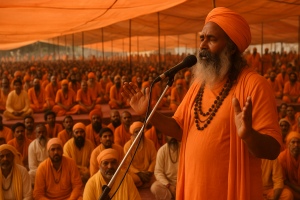In the ever-evolving landscape of modern life, Shri Panchdashnam Atal Akhara stands as a lighthouse of spiritual strength and cultural continuity. In recent months, Atal Akhara has organized several spiritual congregations across India, drawing large numbers of devotees, sadhus, scholars, and seekers to participate in events steeped in Vedic wisdom, bhakti, and dharma-centric discussions.
These recent spiritual congregations, held in locations such as Haridwar, Varanasi, Ujjain, and Prayagraj, have reaffirmed the Akhara’s leadership in promoting Sanatana Dharma, spiritual unity, and collective awakening in the 21st century.
Bringing Saints and Society Together
The hallmark of Atal Akhara’s congregations is the active presence of Mahamandaleshwars, senior Acharyas, and respected sants who lead discourses on:
- The relevance of dharma in modern life,
- The importance of self-discipline and seva (selfless service),
- Interpretations of sacred texts like the Bhagavad Gita, Upanishads, and Ramcharitmanas, and
- The role of youth in the spiritual renaissance.
Each event begins with Vedic chants and yajnas, creating a spiritually charged atmosphere that promotes inner purification and mental peace. The sessions often continue with interactive satsangs and open dialogues, where devotees are encouraged to seek clarity on spiritual and ethical dilemmas.

Cultural and Social Dimensions
What sets these gatherings apart is their integration of social service and cultural preservation. Alongside the spiritual sessions, the Akhara organizes:
- Free health check-up camps,
- Bhandaras (community meals) feeding thousands,
- Book exhibitions promoting Vedic knowledge, and
- Workshops for youth on moral education, yoga, and meditation.
These initiatives reflect the Akhara’s commitment to making dharma accessible, inclusive, and socially relevant. Many attendees come not just for spiritual blessings but to learn, contribute, and grow in awareness.
Digital Outreach and Participation
Understanding the needs of modern society, Atal Akhara has also begun broadcasting portions of its spiritual congregations online, enabling global participation. This hybrid model ensures that devotees from across the world—especially the Indian diaspora—can remain connected to their roots and receive spiritual guidance directly from Akhara’s senior saints.
These virtual sessions are often archived and shared widely, carrying the message of dharma to millions across social media platforms.
Conclusion
Through its recent spiritual congregations, Atal Akhara continues to demonstrate its role as a spiritual and moral anchor for society. These gatherings are more than events—they are movements of consciousness, rooted in the ancient yet responding to the present. They serve as living examples of Sanatana Dharma in action, bringing people together in truth, devotion, and dharmic responsibility.
As the challenges of modernity grow, such congregations are vital reminders that spiritual unity and ancient wisdom remain the foundation of lasting peace and purpose.


